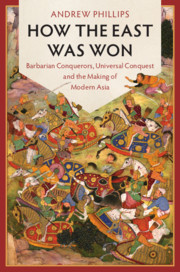Book contents
- How the East Was Won
- LSE International Studies
- How the East Was Won
- Copyright page
- Dedication
- Contents
- Maps
- Preface and Acknowledgements
- Introduction
- 1 From the Rise of the West to How the East Was Won
- 2 The Eurasian Transformation
- 3 The Rise of Asia’s Terrestrial Empires
- 4 European Infiltration and Asian Consolidation in Maritime Asia, 1600–1700
- 5 The Great Asian Divergence
- 6 The East India Company and the Rise of British India, 1740–1820
- 7 Crises of Empire and the Reconstitution of International Orders in South and East Asia, 1820–1880
- Conclusion
- References
- Index
6 - The East India Company and the Rise of British India, 1740–1820
Published online by Cambridge University Press: 01 October 2021
- How the East Was Won
- LSE International Studies
- How the East Was Won
- Copyright page
- Dedication
- Contents
- Maps
- Preface and Acknowledgements
- Introduction
- 1 From the Rise of the West to How the East Was Won
- 2 The Eurasian Transformation
- 3 The Rise of Asia’s Terrestrial Empires
- 4 European Infiltration and Asian Consolidation in Maritime Asia, 1600–1700
- 5 The Great Asian Divergence
- 6 The East India Company and the Rise of British India, 1740–1820
- 7 Crises of Empire and the Reconstitution of International Orders in South and East Asia, 1820–1880
- Conclusion
- References
- Index
Summary
This chapter examines the English East India Company’s (EIC’s) rise to dominance in South Asia from the mid-eighteenth century onwards. The EIC followed Asian precedents by forging its empire through reliance on strategies of define and conquer and define and rule. Company officials first curated indigenous identities to mobilize a uniquely competitive multicultural conquest coalition. They then stabilized their rule through a diversity regime of ecumenical incorporation, which reified religious difference as the primary cleavage on which colonial divide and rule logics would rest. The chapter proceeds in six sections. The first charts the onset of competitive state-building in South Asia following the Mughal Empire’s decline. The second section recounts the EIC’s expansion, before critiquing existing explanations for this. The third to fifth sections advance my substantive explanation for the rise of the ‘Company Raj’. The discussion conforms to the template of emergence, institutionalization, legitimization and consolidation established earlier to explain the rise of the Mughals and the Manchus. The sixth section sums up the chapter’s findings and teases out its broader implications.
- Type
- Chapter
- Information
- How the East Was WonBarbarian Conquerors, Universal Conquest and the Making of Modern Asia, pp. 207 - 246Publisher: Cambridge University PressPrint publication year: 2021

